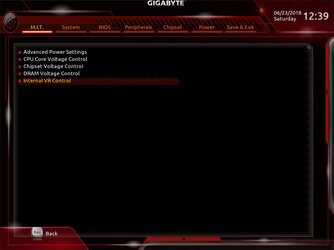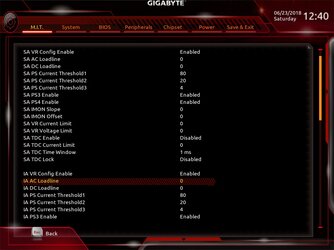- Joined
- Jun 12, 2018
- Location
- Mazowsze / Nottingham UK
EDIT / / /
Upgraded to :
MSI Z390 MPG GAMING EDGE AC
Corsair H115i PRO
Hello guys, my current rig is
8700k with Cooler Master Hyper EVO 212
mobo - Gigabyte Z370 HD3
Corsair 2600MHz 16 GB RAM .
PSU Corsair 750W
I tried to play with overclocking on this motherboard but before the actual i aint done my homework, therefore didn't realize the motherboard has horrible VRM section, high temperatures along with Vcore fluctuating, horrible LLC settings and quite confusing BIOS settings.
Similar situation with CPU Cooler, didn't realize it won't be able to manage the huge amounts of heat generated by 8700k.
Ahh also next month, the plan is to delid the CPU . hooray !
Now then,
I don't want to spend too much money as I'm not a huuuge OC lover, I'm aiming in Max 5GHz, well stable 4.8GHz should be fine.
What i found interesting is :
MOBO :
Asrock Z370 Taichi Socket LGA1151-V2 ATX Motherboard £203.96
https://www.novatech.co.uk/products...et-lga1151-v2-atx-motherboard/z370taichi.html
now, this mobo is knows as a superb for overclocking, it's also very expensive, the only one more expensive is fatality one. Do i really need that TAICHI motherboard if I'm aimng in STABLE Vcore values ? Any cheaper suggestions guys ?
CPU COOLer :
BeQuiet! Dark Rock Pro 4 Air Cooler £79.98
https://www.novatech.co.uk/products/bequiet-dark-rock-pro-4-air-cooler/bk022.html
and same again is it worth to pay that much money for this cooler?
Thanks in advance,
Upgraded to :
MSI Z390 MPG GAMING EDGE AC
Corsair H115i PRO
Hello guys, my current rig is
8700k with Cooler Master Hyper EVO 212
mobo - Gigabyte Z370 HD3
Corsair 2600MHz 16 GB RAM .
PSU Corsair 750W
I tried to play with overclocking on this motherboard but before the actual i aint done my homework, therefore didn't realize the motherboard has horrible VRM section, high temperatures along with Vcore fluctuating, horrible LLC settings and quite confusing BIOS settings.
Similar situation with CPU Cooler, didn't realize it won't be able to manage the huge amounts of heat generated by 8700k.
Ahh also next month, the plan is to delid the CPU . hooray !
Now then,
I don't want to spend too much money as I'm not a huuuge OC lover, I'm aiming in Max 5GHz, well stable 4.8GHz should be fine.
What i found interesting is :
MOBO :
Asrock Z370 Taichi Socket LGA1151-V2 ATX Motherboard £203.96
https://www.novatech.co.uk/products...et-lga1151-v2-atx-motherboard/z370taichi.html
now, this mobo is knows as a superb for overclocking, it's also very expensive, the only one more expensive is fatality one. Do i really need that TAICHI motherboard if I'm aimng in STABLE Vcore values ? Any cheaper suggestions guys ?
CPU COOLer :
BeQuiet! Dark Rock Pro 4 Air Cooler £79.98
https://www.novatech.co.uk/products/bequiet-dark-rock-pro-4-air-cooler/bk022.html
and same again is it worth to pay that much money for this cooler?
Thanks in advance,
Last edited:
 immediate crash after Linx. Then i made some changes in bios, computer shut down hardly popping in with some bios issue asking for resetting to defaults, and guess what. the freq was 4700, and motherboard set up a voltage of
immediate crash after Linx. Then i made some changes in bios, computer shut down hardly popping in with some bios issue asking for resetting to defaults, and guess what. the freq was 4700, and motherboard set up a voltage of

 without delid with temps around 95 reaching 100 celsius oops, therefore im sure that'll be fine with delided cpu where temps are around 70 celsius ( hell yeah) !
without delid with temps around 95 reaching 100 celsius oops, therefore im sure that'll be fine with delided cpu where temps are around 70 celsius ( hell yeah) !